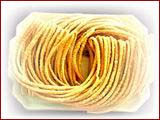Pastry
Stories
The Story of Cut Noodles
It
is said when Mongolian Tartar occupied main land of China and
established Yuan Dynasty, to prevent Hen people from rebelling,
they confiscated all the metal stuff and ordered that ten families
could only share one cooking knife which must be given to Tartar
after being used.
One day, an old
woman made jowar paste for noodles. His husband went to take the
knife, but it was already in use by other people. So he had to
go home. On his way, he found a small sheet of iron and took it
home. |
 |
<Cut Noodles> |
As he went back home,
water was boiling in their pot and the hungry family was waiting for
the knife to slicing the paste. But there was no knife available, the
old man paced up and down, not knowing what to do, suddenly he thought
of the small sheet of iron and told his wife while taking out it,' Just
use this.' The old woman gave a suspicious look at the thin and soft
sheet and said, 'How can it slice the paste!' The old man reacted,'If
slicing does not work then cut it.' The old woman held a wooden board
in the right palm on which was the paste, standing in front of the pot
and cutting the paste into pieces in the boiling water with the iron
sheet in her right hand. After it was cooked, she put them in the bowl
and added sauce. The whole family said it was tasty. Then the recipe
was gradually spread all through northwestern area.
After many changes,
it becomes current Cut Noodles.
The Sanzi Origin
 |
Sanzi(oil
fried wheat) is a traditional Chinese food. It was invented in
Jin Kingdom of Spring and Autumn Period (between 770BC and 476BC)
and has the history of more than 2200 years.
Sanzi can be
kept for several months in winter and spring time and it has played
an important role in the development of Chinese pastry. Sanzi
is crispy, tasty, easily digested and suitable for people of all
age. In Tang Dynasty it was the necessary pastry in official banquet.
|
<San Zi> |
However it is not easy
to make Sanzi. Only bee made from delicately mixed flavors and fried properly
can Sanzi be tasty and crispy.
The Tradition of Eating Noodles In Birthday
Chinese
people have the tradition of eating noodles in birthday. The origin
of the tradition can be traced back to Xihan(West Han)Dynasty.
It is said that
one day, Liu Che, one of emperors of Xihan(West Han)Dynasty, who
believed in anthroposcopy, chatted with his ministers and said.
'According to anthroposcopy book the longer philtrum one has the
longer life he would live, if one has philtrum of 1 inch, he would
live 100 years.'When hearing this, Dong Fangshuo, one of the ministers
began to laugh. Others all feel weird about him and blamed his
rudeness to the emperor. |
|
| <Longevity Noodles> |
Liu Che asked him why
he laughed, and Dong Fangshuo explained, 'I am not laughing at Your Majesty,
but at Pengzu. If one's philtrum is1 inch, he can live 100 years, then
Pengzu lived for 800 years, his philtrum should be 8 inches, so how long
his face should be? Everybody laughed when hearing the explanation.
It seemed that long
face could not ensure a long life and people thought of other way to
express their desire for living a long time. Face has the same pronunciation
as noodles in Chinese, thus long noodles has become the symbol of long
life. Gradually, eating noodles in birthday has been a tradition in
China.
During the end of Donghan(Eastern
Han)Dynasty, Zhang Zhongjing, master of Chinese traditional medicine was
appointed the prefect of Changsha(in today's Hunan Province). Soon after,
plague spread, he resigned and decided to go back hometown and be a professional
doctor. It was a chilly winter, on his way home, he saw people suffering
cold and hunger with their ears frostbitten. Too many people died. Then
he built a shed with a big pod in it. He boiled mutton, pepper and herbal
medicine for shaking off cold in the pod. After a certain time, he took
out the mutton and medicine, chopped them into crumbs, wrapped them with
sheets of flour in the shape of ear and boiled again. After that he gave
them to the poor people who ate them all through the winter and their
cold and frostbitten ears were cured. Since then people learned to make
the food and named it Jiaoer(Ear Dumpling).
Ever since then, in every
Winter Solstice people made this food. As the name Jiaoer was hard to
pronounce, it became Jiaozi. Jiaozi has deeply rooted in Chinese people's
mind and become a symbol of Chinese food.
|